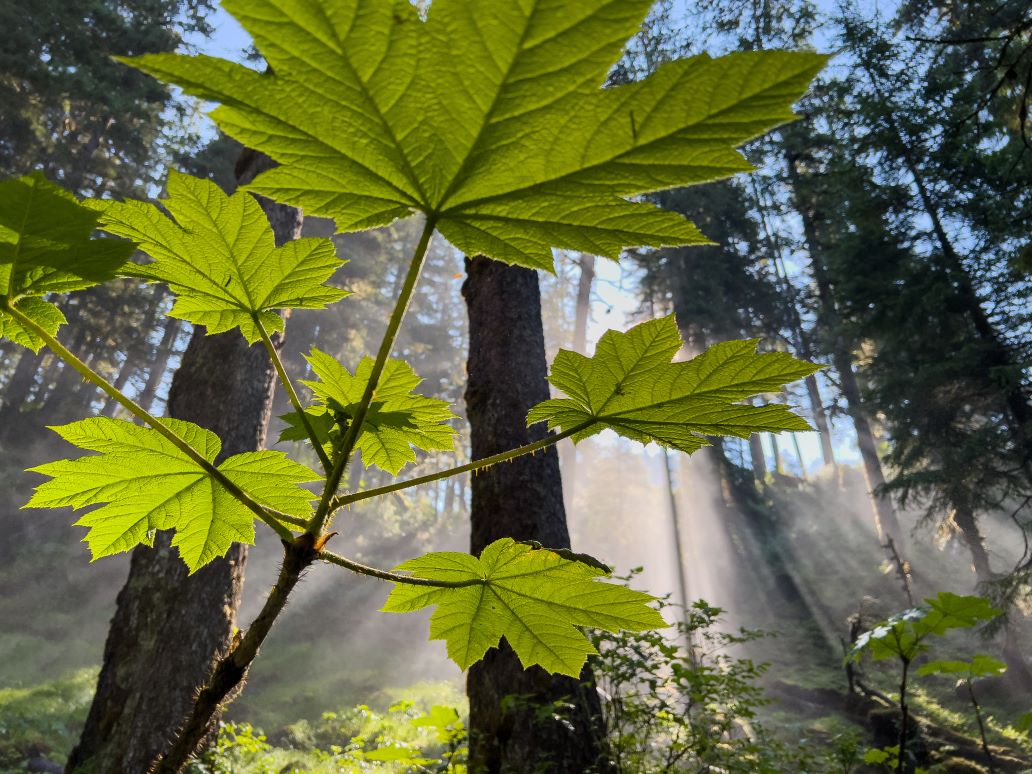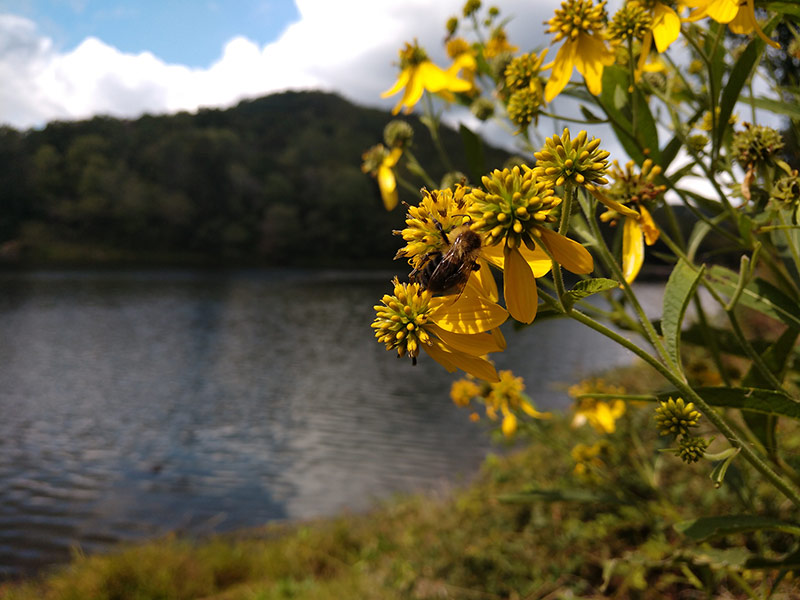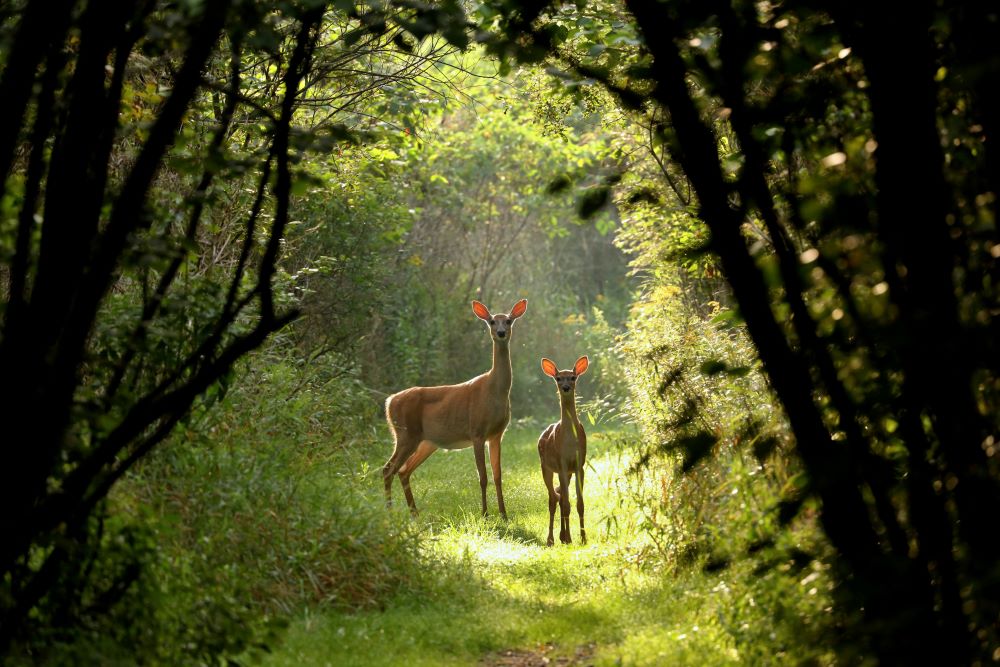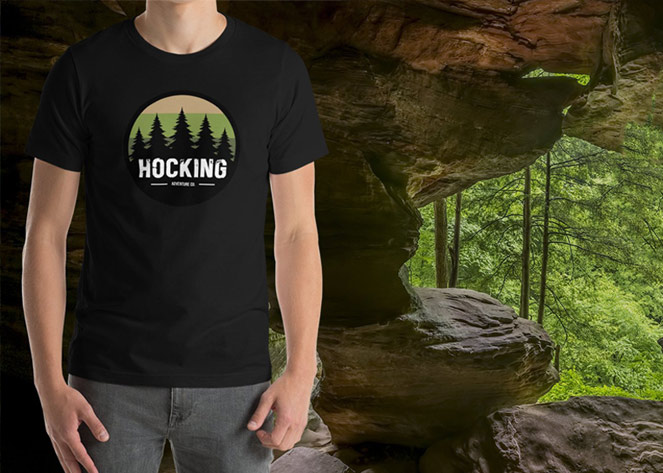Nestled in the heart of the Midwest, Hocking Hills welcomes you with open arms to explore its remarkable natural wonders. This enchanting region is a haven of breathtaking landscapes, diverse ecosystems, and vibrant flora that will leave you in awe. This guide will cover all of the Hocking Hills plants and trees you’re likely to encounter while exploring this gorgeous landscape.
Embracing a temperate climate, Hocking county enjoys warm summers and cool winters, creating the perfect balance for a flourishing natural environment. Thanks to its unique geographical location and varied topography, Hocking Hills boasts an incredible biodiversity. Rich soils, plentiful rainfall, and varying elevations combine to provide an ideal habitat for a wide array of plant species.
So, lace up your hiking boots, grab your camera, and get ready to immerse yourself in the captivating beauty of Hocking Hills’ plant life! Explore the trails, breathe in the fresh scents, and marvel at the intricate details that make this region a true paradise for nature lovers. Whether you’re a botany enthusiast or simply appreciate the wonders of the natural world, Hocking Hills is sure to leave a lasting impression with its vibrant and ever-changing tapestry of plants.
Hocking Hills Plants and Trees
In Hocking Hills, you’ll find a diverse array of plant species that can be categorized into several groups based on their characteristics and ecological roles. Here are some of the main categories of plants found in the region, along with examples of each:
Trees
Hocking Hills is home to a variety of tree species, including both deciduous and evergreen varieties. Common trees in the region include:
- Oak (Quercus spp.): Species such as white oak, red oak, and black oak are prevalent in Hocking Hills. They provide important habitats, acorns for wildlife, and beautiful fall foliage.
- Hickory (Carya spp.): Shagbark hickory and pignut hickory are among the hickory species found in the region, known for their distinctive bark and delicious nuts.
- Maple (Acer spp.): Sugar maple, red maple, and silver maple are a few examples of maple trees that grace the forests of Hocking Hills, offering vibrant foliage in the autumn.
- Beech (Fagus grandifolia): American beech trees are recognizable by their smooth gray bark and provide nuts that are a valuable food source for wildlife.
- Pine (Pinus spp.): Eastern white pine and Virginia pine are evergreen conifers found in Hocking Hills, adding year-round greenery to the landscape.
Wildflowers
Hocking Hills boasts an impressive variety of wildflowers, adding splashes of color and beauty to the forest floor and meadows. Some notable wildflowers include:
- Trillium (Trillium spp.): Trilliums are spring ephemerals that display stunning white, pink, or yellow blooms and are often considered a symbol of the region.
- Bloodroot (Sanguinaria canadensis): Bloodroot features delicate white flowers and distinctive lobed leaves. Its red sap was historically used for dyeing.
- Dutchman’s Breeches (Dicentra cucullaria): This unique wildflower resembles tiny upside-down pantaloons and adds charm to the spring landscape.
- Wild Geranium (Geranium maculatum): With its vibrant pink or purple flowers, wild geranium adds a splash of color to the woodland understory.
Ferns
Hocking Hills is also home to numerous fern species, which thrive in the region’s shady, moist environments. Ferns in Hocking Hills include:
- Maidenhair Fern (Adiantum pedatum): This delicate fern with fan-shaped fronds can be found in moist wooded areas, often near waterfalls.
- Christmas Fern (Polystichum acrostichoides): Named for its evergreen fronds that persist throughout the winter, the Christmas fern is a common sight in Hocking Hills.
- Sensitive Fern (Onoclea sensibilis): This fern is named for its sensitivity to frost, with its fronds turning brown and withering at the first sign of cold weather.
Mosses and Lichens
The damp and shaded environments of Hocking Hills provide ideal conditions for the growth of mosses and lichens. These organisms add texture and color to rocks, tree trunks, and forest floors. Examples include:
- Feather Moss (Hypnum spp.): This moss forms dense, feathery mats on rocks, fallen logs, and soil surfaces.
- Reindeer Lichen (Cladonia spp.): Reindeer lichen is a unique lichen that can be found on the forest floor and resembles miniature trees.
These are just a few examples of the diverse plant life you can encounter in Hocking Hills. Exploring the region’s trails and natural areas will reveal even more fascinating species, each playing a vital role in the ecosystem and contributing to the region’s natural beauty.
Full List of Hocking Hills Plants
The Hocking Hills region in Ohio boasts a captivating variety of plants, including a delightful array of wildflowers, ferns, mosses, and lichens. As you traverse the trails, you’ll encounter delicate spring ephemerals bursting forth, hardy evergreens providing year-round greenery, and everything in between. The fertile soils, shaded ravines, and meandering streams create the perfect conditions for this botanical wonderland to thrive.
Here is a comprehensive list of the Hocking Hills plants you can encounter while exploring:
- Trillium: Several species of trillium can be found in Hocking Hills, including the white trillium (Trillium grandiflorum) with its three-petaled white flowers.
- Hepatica: Also known as liverwort, hepatica (Hepatica nobilis) showcases delicate flowers in shades of blue, pink, and white. It’s often one of the first wildflowers to bloom in the spring.
- Jack-in-the-Pulpit: This unique plant (Arisaema triphyllum) features a hooded structure that surrounds a spadix, resembling a preacher in a pulpit. It can be found in moist woodland areas.
- Wild Ginger: Look for wild ginger (Asarum canadense), a low-growing plant with heart-shaped leaves and hidden, bell-shaped reddish-brown flowers. Its roots have a pleasant aroma similar to ginger.
- Dutchman’s Breeches: These dainty, white flowers (Dicentra cucullaria) resemble tiny upside-down breeches. They bloom in early spring and are commonly found along stream banks.
- Bloodroot: Bloodroot (Sanguinaria canadensis) gets its name from the red sap that oozes from its root when cut. Its white flowers appear in early spring and close during cloudy or rainy weather.
- Wild Geranium: Wild geranium (Geranium maculatum) displays delicate pink to lavender flowers with distinctive veined petals. It can be found in moist woodlands and along stream banks.
- Showy Orchis: This beautiful orchid (Galearis spectabilis) showcases clusters of pale pink to white flowers with fringed lips. It’s a rare find in Hocking Hills and typically blooms in spring.
- Indian Pipe: Indian pipe (Monotropa uniflora) is a unique non-photosynthetic plant that lacks chlorophyll. It appears ghostly white and can be found in shaded, moist areas.
- Mayapple: Mayapple (Podophyllum peltatum) features large umbrella-like leaves and produces a single white flower. Its yellow fruit is poisonous when unripe but edible when fully ripe.
- Jewelweed: Jewelweed (Impatiens capensis) is a common wildflower with orange or yellow tubular flowers. Its succulent stems are believed to provide relief from poison ivy rashes.
- Wild Columbine: Wild columbine (Aquilegia canadensis) displays distinctive red and yellow flowers with backward-curving spurs. It’s a favorite of hummingbirds and can be found in rocky areas.
- Virginia Bluebell: Virginia bluebell (Mertensia virginica) showcases clusters of bell-shaped, sky-blue flowers that gradually change to pink as they age. It blooms in the spring and prefers moist soils.
- Cardinal Flower: With its vibrant red tubular flowers, the cardinal flower (Lobelia cardinalis) is a standout in Hocking Hills. It attracts hummingbirds and thrives in wet habitats.
- Goldenrod: Various species of goldenrod (Solidago spp.) are abundant in Hocking Hills. These tall, yellow-flowered plants provide late-season nectar for pollinators.
- Purple Coneflower: This striking perennial (Echinacea purpurea) features purple petals and a spiky central cone. It’s a favorite of butterflies and is known for its medicinal properties.
- Bee Balm: Bee Balm (Monarda spp.) is a showy, fragrant wildflower that attracts bees, butterflies, and hummingbirds. It comes in various colors, including shades of red, pink, and purple.
- Wild Bergamot: Wild bergamot (Monarda fistulosa) is a member of the mint family and has lavender to pinkish-purple flowers. It’s known for its aromatic leaves and is often used in herbal teas.
- Black-Eyed Susan: Black-eyed Susan (Rudbeckia hirta) is a cheerful wildflower with bright yellow petals and a dark brown or black center. It’s a common sight along roadsides and in open fields.
- Wild Blue Phlox: Wild blue phlox (Phlox divaricata) produces clusters of fragrant, pale blue to lavender flowers. It thrives in shaded, moist areas and blooms in the spring.
- Wild Strawberry: Look for wild strawberry (Fragaria virginiana), a low-growing plant with white flowers and small, sweet fruits. It’s a favorite snack for wildlife and can be found in sunny locations.
- Woodland Sunflower: Woodland sunflower (Helianthus divaricatus) features bright yellow, daisy-like flowers that bloom in late summer. It thrives in woodland edges and along trails.
- Wild Sarsaparilla: Wild sarsaparilla (Aralia nudicaulis) is a woodland plant with large, compound leaves and small, greenish-white flowers. Its roots have a taste reminiscent of the traditional sarsaparilla flavor.
- Wild Bleeding Heart: Wild bleeding heart (Dicentra eximia) displays delicate, heart-shaped flowers in shades of pink. It blooms from spring to early summer and prefers shady, woodland areas.
- Yellow Lady’s Slipper: This rare and enchanting orchid (Cypripedium parviflorum) features a yellow, pouch-like flower with maroon or brown markings. It can be found in moist, wooded areas.
- Mosses and Lichens: Hocking Hills is home to a wide variety of mosses and lichens, adding lushness and texture to the forest landscape. Look for carpets of mosses and intricately patterned lichens on rocks and trees.
Remember to respect and appreciate these plants by observing them without disturbing or picking them. Hocking Hills’ plant diversity contributes to the region’s unique beauty, and preserving their habitats ensures future generations can enjoy them as well.

Full List of Hocking Hills Trees
Step into the lush forests that define Hocking Hills, and you’ll be greeted by a tapestry of majestic trees. From the sturdy oak and hickory to the graceful maple and beech, these towering hardwoods dominate the landscape, providing shelter and sustenance for countless wildlife species. As the seasons change, the forests come alive with a kaleidoscope of colors, with vibrant foliage in the fall that attracts visitors from far and wide.
The Hocking Hills region in Ohio is blessed with a diverse array of trees, contributing to its stunning landscapes and rich ecosystem.
Here is a comprehensive list of the Hocking Hills trees you can encounter while exploring the woods:
- Oak Trees: Hocking Hills is home to various oak species, including white oak (Quercus alba), red oak (Quercus rubra), black oak (Quercus velutina), and chestnut oak (Quercus montana). Oaks are majestic hardwoods with distinctive lobed leaves and provide essential habitats and food sources for wildlife.
- Hickory Trees: Hocking Hills boasts several hickory species, such as shagbark hickory (Carya ovata) and pignut hickory (Carya glabra). Hickories have compound leaves and produce delicious nuts that are enjoyed by both humans and wildlife.
- Maple Trees: Look for a variety of maple species, including sugar maple (Acer saccharum), red maple (Acer rubrum), and silver maple (Acer saccharinum). Maples are known for their vibrant fall foliage and produce sweet sap used for maple syrup.
- Beech Trees: American beech (Fagus grandifolia) is a common tree in Hocking Hills. It has smooth, gray bark and produces edible beechnuts that are a food source for wildlife.
- Sycamore Trees: Sycamores (Platanus occidentalis) are large, deciduous trees with distinctive mottled bark that peels away to reveal lighter-colored patches. They can be found along streams and rivers in Hocking Hills.
- Ash Trees: Ash species, such as white ash (Fraxinus americana) and green ash (Fraxinus pennsylvanica), can be found in Hocking Hills. Unfortunately, they are susceptible to the invasive emerald ash borer, which has impacted their populations.
- Tulip Trees: Tulip trees (Liriodendron tulipifera) are towering trees with distinctive tulip-shaped leaves and showy yellow-green flowers. They are prized for their timber and add beauty to the Hocking Hills landscape.
- Hemlock Trees: Eastern hemlock (Tsuga canadensis) is an evergreen conifer that thrives in the cool, shaded areas of Hocking Hills. It provides a dense canopy and serves as important habitat for various wildlife species.
- Eastern Redcedar: Eastern redcedar (Juniperus virginiana) is a hardy evergreen tree with aromatic foliage. It can be found in drier, open areas of Hocking Hills and provides food and shelter for wildlife.
- Black Cherry: Black cherry (Prunus serotina) is a native tree with shiny, serrated leaves and dark, cherry-like fruits that are enjoyed by birds and mammals. It adds beauty to Hocking Hills with its white springtime blossoms.
- White Pine: White pine (Pinus strobus) is a tall evergreen tree with soft needles in bundles of five. It is less common in Hocking Hills but can be found in certain areas, providing a touch of green throughout the year.
- Eastern Redbud: Eastern redbud (Cercis canadensis) is a small, ornamental tree that adds bursts of vibrant pink flowers to the Hocking Hills landscape in early spring.
- American Hornbeam: American hornbeam (Carpinus caroliniana), also known as musclewood or blue beech, is a small tree with distinctive fluted bark. It thrives in the understory of Hocking Hills forests.
- Dogwood Trees: Flowering dogwoods (Cornus florida) are common in Hocking Hills and are known for their beautiful springtime blossoms. These small to medium-sized trees display clusters of white or pink flowers and have distinctive, flaky bark.
- Black Walnut: Black walnut (Juglans nigra) is a valuable tree species found in Hocking Hills. It produces edible nuts encased in hard shells and has dark, deeply furrowed bark.
- Eastern Cottonwood: Eastern cottonwood (Populus deltoides) is a fast-growing tree that can reach impressive heights. It has heart-shaped leaves and produces fluffy cotton-like seeds that disperse in the wind.
- American Beech: American beech (Fagus grandifolia) is a shade-tolerant tree with smooth, gray bark. It often forms a dense canopy and provides habitat for various wildlife species.
- American Basswood: American basswood (Tilia americana), also known as American linden, is a large deciduous tree with heart-shaped leaves and fragrant, yellowish flowers. It attracts pollinators and provides valuable timber.
- Buckeye Trees: Ohio’s state tree, the Ohio buckeye (Aesculus glabra), can be found in Hocking Hills. These medium-sized trees produce distinctive nuts encased in spiky husks and display showy clusters of white flowers.
- Persimmon Trees: Persimmon trees (Diospyros virginiana) are small to medium-sized trees that bear edible orange fruits in the fall. They are cherished by both humans and wildlife.
- Kentucky Coffeetree: Kentucky coffeetree (Gymnocladus dioicus) is a unique tree with compound leaves and large, brown seed pods. It prefers well-drained soil and is known for its striking appearance.
- Eastern Hemlock: Eastern hemlock (Tsuga canadensis) is an evergreen conifer that thrives in the cool, shaded areas of Hocking Hills. Its graceful branches and feathery foliage add beauty to the landscape.
- Hackberry: Hackberry (Celtis occidentalis) is a medium-sized tree with distinctive warty bark and small, berry-like fruits. It provides food for birds and other wildlife.
- Serviceberry: Several species of serviceberry (Amelanchier spp.) can be found in Hocking Hills. These small trees or large shrubs produce delicate white flowers in the spring and bear edible berries loved by wildlife.
- Eastern White Cedar: Eastern white cedar (Thuja occidentalis), also known as arborvitae, is a small to medium-sized evergreen tree with scale-like leaves. It prefers moist, shaded areas and can be found in Hocking Hills’ ravines and wetlands.
This comprehensive list showcases the remarkable diversity of trees that grace the forests of Hocking Hills. As you explore this magnificent region, take time to appreciate the beauty and ecological importance of these trees that contribute to the unique charm and vitality of Hocking Hills.

Tips for Exploring Plants and Wildlife in Hocking Hills
Embrace the wonders of nature in Hocking Hills, where the rich biodiversity and breathtaking landscapes create a haven for plants and wildlife. Located in southeastern Ohio, Hocking Hills is renowned for its lush forests, cascading waterfalls, and rugged cliffs that form an idyllic backdrop for a thriving ecosystem. From towering trees to delicate wildflowers, and from elusive wildlife to intricate mosses and lichens, this region invites you to embark on an exploration of its diverse flora and fauna.
As you traverse the winding trails and meandering streams, you’ll discover an abundance of plant species that paint the landscape with vibrant colors and captivating scents. Majestic trees like oaks, hickories, and maples dominate the woodlands, their branches offering shade and shelter for a variety of animals. Delicate wildflowers grace the forest floor, carpeting it with hues of white, pink, and yellow during the spring and summer months. Ferns unfurl their delicate fronds in shaded nooks, while mosses and lichens add a touch of intrigue to rocks and fallen logs.
Here are some trail tips for exploring local plant life:
- Stay on designated trails to minimize your impact on the delicate ecosystem and avoid disturbing wildlife habitats.
- Be respectful and observe wildlife from a safe distance. Use binoculars or a telephoto lens for close-up views.
- Practice Leave No Trace principles. Take your trash with you, minimize noise, and avoid picking or damaging plants.
- Consider visiting Hocking Hills during different seasons to witness the changing landscapes and the unique flora and fauna each time.
- Engage in guided nature walks or join educational programs to learn more about Hocking Hills’ plants and wildlife from knowledgeable experts.
Hocking Hills is not just a sanctuary for plants; it’s also a thriving habitat for wildlife. Keep your eyes peeled for glimpses of white-tailed deer gracefully leaping through the underbrush, or the playful antics of squirrels as they scamper from tree to tree. With luck and patience, you may even spot elusive creatures like raccoons, foxes, and coyotes. Bird enthusiasts will delight in the symphony of songs that fill the air, as colorful warblers, woodpeckers, and owls make their presence known.
As you explore the enchanting trails and natural areas of Hocking Hills, take a moment to appreciate the intricate balance of this ecosystem. Each plant and creature plays a vital role, contributing to the beauty and harmony of this natural wonderland. Whether you’re an avid botanist, a wildlife enthusiast, or simply someone who appreciates the wonders of nature, Hocking Hills beckons you to immerse yourself in its diverse and captivating world.
So, grab your hiking boots, your binoculars, and a sense of wonder as you set out to explore the plants and wildlife of Hocking Hills. Let the rustling leaves, fragrant blooms, and the chorus of nature guide you on a journey of discovery. Embrace the serenity and marvel at the intricate details that make this region a true haven for nature lovers. In Hocking Hills, the beauty of the natural world unfolds before your eyes, inviting you to connect with the wonders of plants and wildlife in a truly unforgettable way.











Share This Page